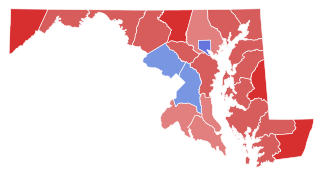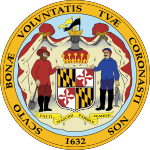
The 1992 United States Senate election in Maryland was held on November 3, 1992. Incumbent Democratic U.S. Senator Barbara Mikulski won re-election to a second term.

The 1986 United States Senate election in Maryland was held on November 4, 1986. Incumbent Republican Senator Charles Mathias Jr. decided to retire instead of seeking a fourth term. Democratic U.S. Representative Barbara Mikulski defeated Reagan Administration official Linda Chavez for the open seat. Mikulski's swearing-in marked the first time since 1969 where Democrats held both Senate seats from Maryland.

The 1932 United States Senate election in Maryland was held on November 8, 1932. Incumbent Democratic U.S. Senator Millard Tydings was re-elected to a second term in office, defeating Republican Wallace Williams.

The 1952 United States Senate election in Maryland was held on November 4, 1952.

The 1956 United States Senate election in Maryland was held on November 6, 1956. Incumbent Republican U.S. Senator John Marshall Butler was re-elected to a second term in office, defeating Democratic businessman George P. Mahoney.

The 1970 United States Senate election in Maryland took place on November 3, 1970. Incumbent Democratic U.S. Senator Joseph Tydings ran for re-election to a second term, but was narrowly defeated by Republican U.S. Representative J. Glenn Beall Jr.

The 1938 United States Senate election in Maryland was held on November 8, 1938. Incumbent Democratic U.S. Senator Millard Tydings was re-elected to a third term in office, easily defeating Republican Oscar Leser.

The 1974 United States Senate election in Maryland was held on November 5, 1974, to elect one of Maryland's members to the United States Senate. Incumbent Republican U.S. Senator Charles Mathias Jr. won re-election to a second term defeating Baltimore City Councilwoman Barbara Mikulski, who won the Senate election 12 years later for this same seat upon Mathias' retirement.

The 1950 United States Senate election in Maryland was held on November 7, 1950. Incumbent Democratic U.S. Senator Millard Tydings ran for a fifth term in office, but was defeated by Republican John Marshall Butler.

The 1916 United States Senate election in Maryland was held on November 7, 1916.

The 1922 United States Senate election in Maryland was held on November 7, 1922.

The 1926 United States Senate election in Maryland was held on November 2, 1926. Incumbent Republican U.S. Senator Ovington Weller ran for re-election to a second term in office, but was beaten badly by Democratic U.S. Representative Millard Tydings of Havre de Grace.

The 1928 United States Senate election in Maryland was held on November 5, 1928.

The 1934 United States Senate election in Maryland was held on November 5, 1934.

The 1940 United States Senate election in Maryland was held on November 5, 1940.

The 1944 United States Senate election in Maryland was held on November 7, 1944. Incumbent Democratic U.S. Senator Millard Tydings was re-elected to a fourth term in office over Republican Blanchard Randall Jr.

The 1962 United States Senate election in Maryland was held on November 6, 1962. Incumbent Republican U.S. Senator John Marshall Butler did not run for re-election to a third term in office. Democratic U.S. Representative Daniel Brewster won the re-election to succeed him easily over Republican U.S. Representative Edward Tylor Miller.

The 1964 United States Senate election in Maryland was held on November 3, 1964.

The 1980 United States Senate election in Maryland took place on November 4, 1980.

The 1958 United States Senate election in Maryland was held on November 4, 1958.
























